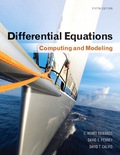
Concept explainers
(a)
Program Description: Purpose of the problem is to obtain the approximate values of
(a)
Explanation of Solution
Given information:
The differential problem is
The exact solution of the differential equation is
The two step size is
Calculation:
The differential problem can be represented as,
The Euler’s formula for
The Euler’s formula for
Substitute 0 for
Substitute 0 for
Substitute 0 for
Substitute 0 for
Substitute 1 for
Substitute 1 for
Substitute
Substitute
Therefore, the value of
Conclusion:
Thus, the approximate values of
(b)
Program Description: Purpose of the problem is to find the approximate values of
(b)
Explanation of Solution
Given information:
The differential problem is
The exact solution of the differential equation is
The two step size is
Calculation:
The improved Euler’s formula for predicators
The improved Euler’s formula for predicators
Substitute 0 for
Substitute 0 for
Substitute 0 for
Substitute 0 for
The improved Euler’s formula for correctors is shown below.
The improved Euler’s formula for correctors
Substitute 0 for
Substitute 0 for
Substitute 0 for
Substitute 0 for
Therefore, the value of
Conclusion:
Thus, the approximate values of
(c)
Program Description: Purpose of the problem is to find the approximate values of
(c)
Explanation of Solution
Given information:
The differential problem is
The exact solution of the differential equation is
The two step size is
Calculation:
The Runge-Kutta iteration formulas are shown below.
The Runge-Kutta iteration formulas are shown below
The value of
The value of
Substitute 0 for
Substitute 0 for
Substitute 0 for
Substitute 0 for
Substitute 0 for
Substitute 0 for
Substitute 0 for
Substitute 0 for
Substitute
Substitute
The exact solution
The exact solution
It can be observed that the Runge-Kutta method is more closes to the exact solution of the differential equation.
Conclusion:
Thus, the approximate values of
Want to see more full solutions like this?
Chapter 4 Solutions
EBK DIFFERENTIAL EQUATIONS
 Calculus: Early TranscendentalsCalculusISBN:9781285741550Author:James StewartPublisher:Cengage Learning
Calculus: Early TranscendentalsCalculusISBN:9781285741550Author:James StewartPublisher:Cengage Learning Thomas' Calculus (14th Edition)CalculusISBN:9780134438986Author:Joel R. Hass, Christopher E. Heil, Maurice D. WeirPublisher:PEARSON
Thomas' Calculus (14th Edition)CalculusISBN:9780134438986Author:Joel R. Hass, Christopher E. Heil, Maurice D. WeirPublisher:PEARSON Calculus: Early Transcendentals (3rd Edition)CalculusISBN:9780134763644Author:William L. Briggs, Lyle Cochran, Bernard Gillett, Eric SchulzPublisher:PEARSON
Calculus: Early Transcendentals (3rd Edition)CalculusISBN:9780134763644Author:William L. Briggs, Lyle Cochran, Bernard Gillett, Eric SchulzPublisher:PEARSON Calculus: Early TranscendentalsCalculusISBN:9781319050740Author:Jon Rogawski, Colin Adams, Robert FranzosaPublisher:W. H. Freeman
Calculus: Early TranscendentalsCalculusISBN:9781319050740Author:Jon Rogawski, Colin Adams, Robert FranzosaPublisher:W. H. Freeman
 Calculus: Early Transcendental FunctionsCalculusISBN:9781337552516Author:Ron Larson, Bruce H. EdwardsPublisher:Cengage Learning
Calculus: Early Transcendental FunctionsCalculusISBN:9781337552516Author:Ron Larson, Bruce H. EdwardsPublisher:Cengage Learning





